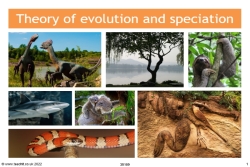Theory of evolution and speciation

This comprehensive PowerPoint lesson includes a series of nine engaging tasks to develop biology students' understanding of how the theory of evolution by natural selection and speciation arose.
The PowerPoint includes learning outcomes and objectives, a starter and plenary and a range of group activities, questions and learning checks, plus individual activities and consolidation tasks. Students will learn about the impact of Darwin, Wallace and Lamarck's work in the development of the theory of evolution by natural selection.
Students complete a varied range of tasks, from note-taking, dual-coding and summarising to creating models and diagrams to show speciation. There are also rich discussion and presentation tasks designed to encourage lots of on-topic classroom talk and to develop students' oracy skills.
There's also a focus on Galapagos finches as an example of how different species evolve.
An example slide from the PowerPoint lesson:
The theory of natural selection was only gradually accepted on a wide scale. Why do you think this was the case?
Task 4
1. Pick one of the scientific breakthroughs listed below:
2. Imagine you are the first scientist to propose this theory.
3. Spend a couple of minutes preparing your persuasive argument to convince your neighbour scientist that your theory is correct.
Scientific breakthroughs:
• The Earth is not flat, it’s round.
• Carbon dioxide is contributing to global warming.
• The spread of disease in hospitals can be reduced by washing hands frequently.
• The risk of cervical cancer can be greatly reduced if teenage girls are vaccinated against the human papilloma virus (HPV).
• The Sun doesn’t orbit the Earth, the Earth orbits the Sun.
